SEO stands for Search Engine Optimization. You’re going to optimize your website, video or page to perform better in search engines.
There are so many methods, tools and tactics for performing better in search engines that you can’t see the forest for the trees.
With every Google update, do you hold your heart for what it will do to your organic results?
I’m going to show you how to:
- Achieve sustainable growth with SEO
- Create timeless content
- Know whether to outsource SEO or not
By focusing on SEO strategy and not having tunnel vision on Google.
Let’s start…
What is SEO?
SEO stands for Search Engine Optimization.
This term encompasses all the work you do to rank higher organically in search engines, such as:
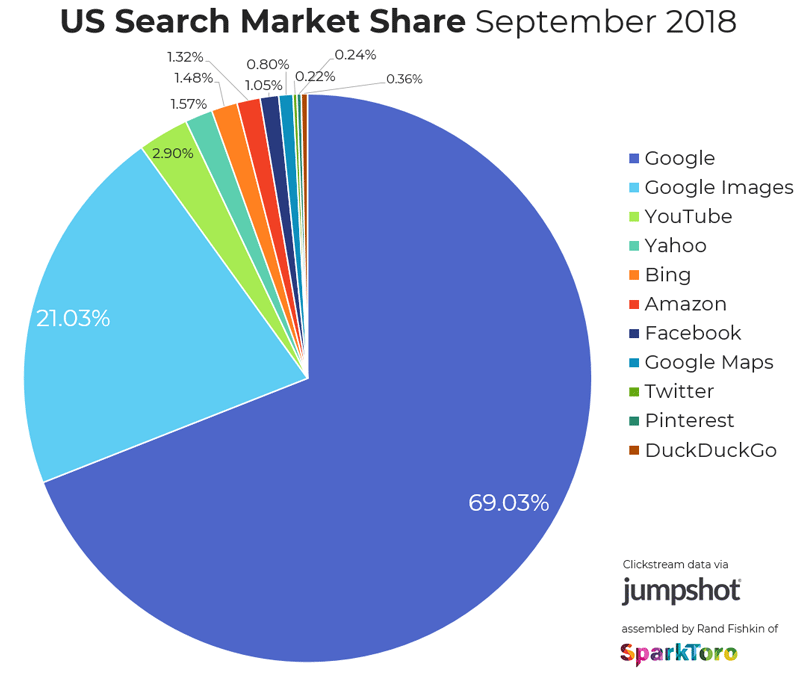
Also consider search engines within platforms such as Amazon, YouTube, LinkedIn or Instagram, for example.
A higher ranking automatically means more volume:
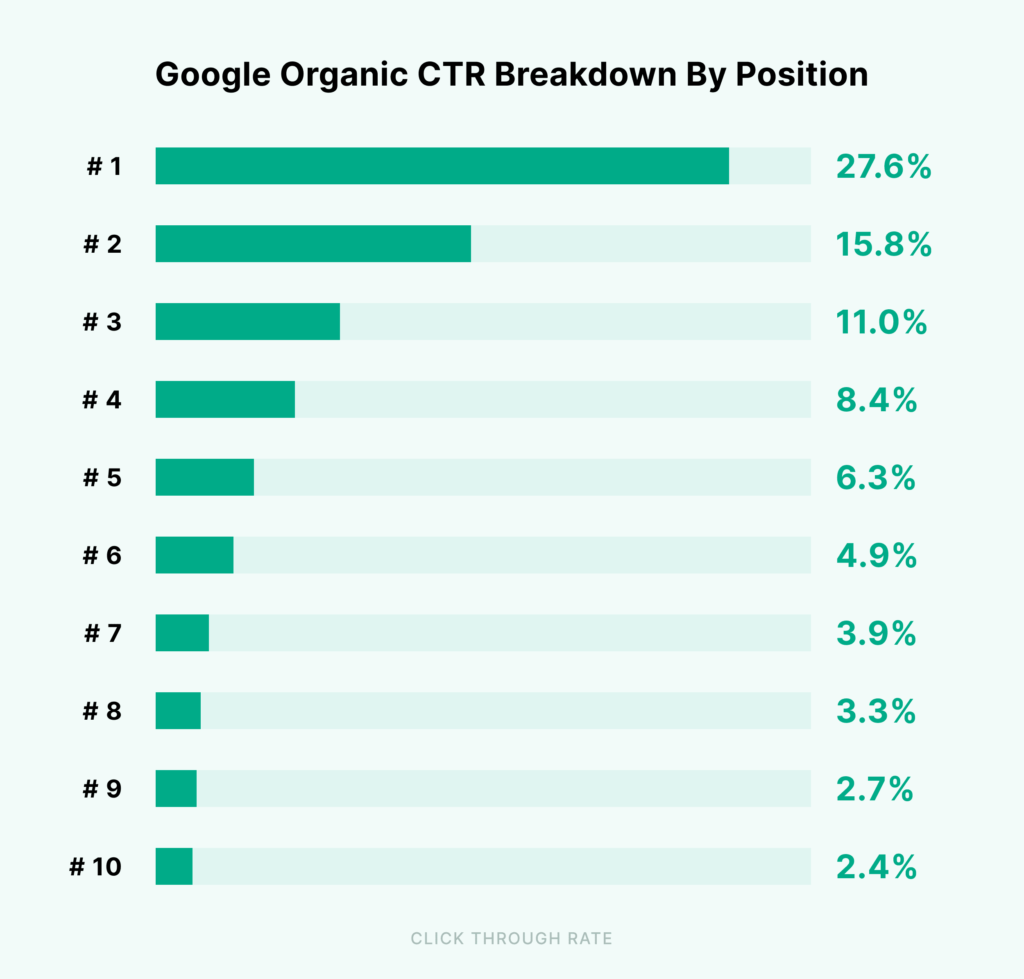
The great thing about SEO is that if you do it right you can therefore get a lot of “free” traffic. Completely free of course is not, because SEO costs time and therefore money.
You often see distinctions made between:
- On-page SEO: all SEO-related things that happen on your website.
- Off-page SEO: all SEO-related things that do not happen directly on your website.
SEO work can also be classified under 3 forms:
- White hat SEO: optimizing content to be the best search result on a search query and search intent. In other words, complying with the Google Webmaster Guidelines.
- Grey hat SEO: combination of white hat and black hat SEO in which you create quality content and purchase spam links to do link building, for example.
- Black hat SEO: all search engine optimization techniques that go against the guidelines of search engines such as Google. Examples include naming the same keyword too often.
SEO and SEA
In addition to the organic results in search engines, you often have the paid results (Search Engine Advertising).
Within Google, for example, this is Google Ads and within Amazon, these are Sponsored Products. Within these advertising products, you pay per click on your ad.
| SEO | SEA | |
| Price | Free, only costs time. | Cost per click, or visitor to your website. |
| Duration | Long-term growth, no immediate result. | Direct results. |
| Targeting | No ability to target a specific audience outside of your keyword. | Extensive targeting possibilities. |
| Position | Possible to be at the top of search results, but below paid results. | Guarantee of top 1 position. |
In addition to SEO and SEA, you also have SEM, which stands for Search Engine Marketing and is the umbrella activity of SEO and SEA.
Ranking factors
In the end, it’s all about being the most relevant search result for the search term and intent of the person searching.
Of course, on platforms themselves, there are countless optimization opportunities you need to comply with and tactics to rank higher. I’m not going to bore you with that, as plenty of articles have already been written about this.
Google and other search engines are getting better at matching searches to search results, but still offer guidelines in which you can improve:
- Meaning: the underlying meaning and correct interpretation of a search query. For example, if someone searches for a pizzeria you will see local search results.
- Relevance: if your search result uses keywords that match the search query exactly, the relevance is more likely to be good. Also, data is used to measure the interaction with a search result to evaluate whether the search result was actually relevant.
- Quality: is determined by expertise, authority and reliability of a website and/or writer.
- Usability: websites and content that are easier to access and more usable will be prioritized. In this, think for example of a fast loading time and few pop-ups.
- Context: consider, for example, location and search history that Google uses to determine which search results are a better fit. For example, if you Google ‘Football’ in America you will get rugby results and in England you will get soccer results.
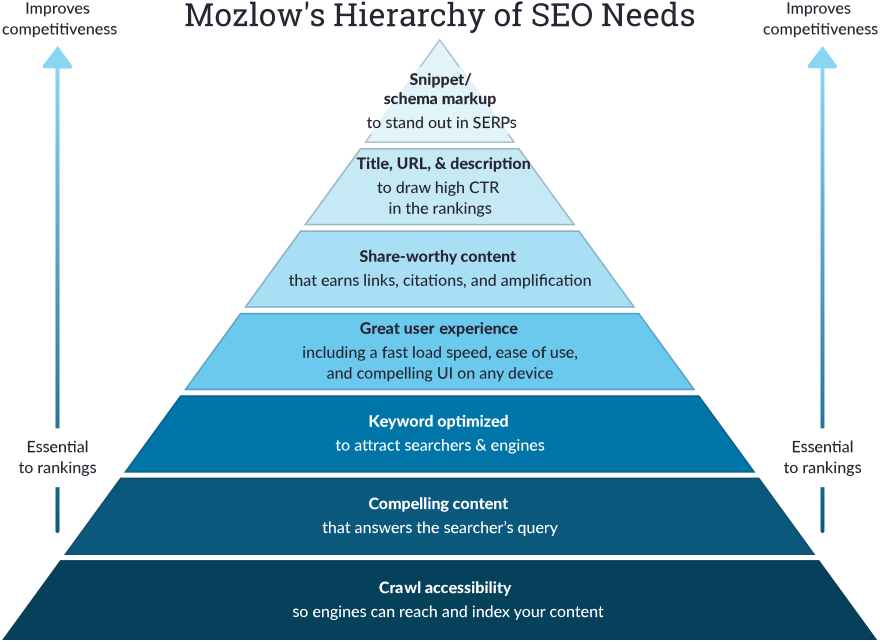
In addition there are 2 acronyms you should at least consider…
TAC
- Technique: your website must be understandable for Google, for example a clear website structure, good loading speed, as few error pages as possible, etc.
- Authority: Google determines the reliability of your website on the basis of your authority score. This is built up based on the number of links you get from other websites, among other things.
- Content: anything that somehow reinforces information to a searcher falls under content. It is important that the content is the best answer a search engine can provide to a particular query and search intent.
EAT
- Expertise: the content writer should be seen as an expert.
- Authoritativeness: the quality of a website’s link profile.
- Trustworthiness: things that contribute to the trustworthiness of your website, such as an SSL certificate and contact information.
Additionally, keep an eye on websites such as Moz, Ahrefs and SEMrush to be aware of the latest SEO tactics so you can take advantage of them.
Amazon
At its core, it remains the same, delivering the best search result on a search query combined with search intent.
Amazon’s ranking factors match Google relatively well, but the details are different. This is because with Amazon, the technology is already taken out of your hands for you, but the content you post and your buyers’ results become important as a result.
And also for YouTube, for example, the core remains the same only the details change.
SEO Strategy
How do you get started with SEO?
- Identify channels
Determine which channels are most relevant to you in terms of organic reach. This could include Google search results, Google Shopping, Google local or perhaps Amazon.
- Start with keyword research
Map the search landscape of your channels. Research which keywords people are using at which stage of the funnel.
- Prioritize keywords
Prioritize your keywords based on volume, intent and competition to start with keywords where you can make a big impact relatively quickly.
- Determine follow-up actions
Based on your keyword research and channels, determine follow-up actions to work on.
- Check the SEO technique
Make sure your SEO Technique is in good shape, otherwise your content will not be indexed (properly).
- Create a content calendar
Ensure sustainable SEO growth by continuing to build valuable content structurally.
- Create, distribute and evaluate content.
Create and distribute your content on different channels. Evaluate the results afterwards to draw conclusions and learnings to build on.
1. Identify channels
From your Customer Journey research you should have found out within which platforms your target audience will orientate on a product or service.
It is then important to be well findable organically on those platforms, think about:
- Google (Shopping, Local, Videos, Images, etc.)
- Bing
- Amazon
- YouTube
2. Start with keyword research
Periodically conduct keyword research within the channels relevant to you.
In it, you try to find out what keywords potential customers are using to search for a product or service so you can start focusing content on relevant keywords.
There are numerous ways to research how users search within certain platforms for specific products or services. Google for “keyword research [platform/channel].
Keywords usually fall under two types:
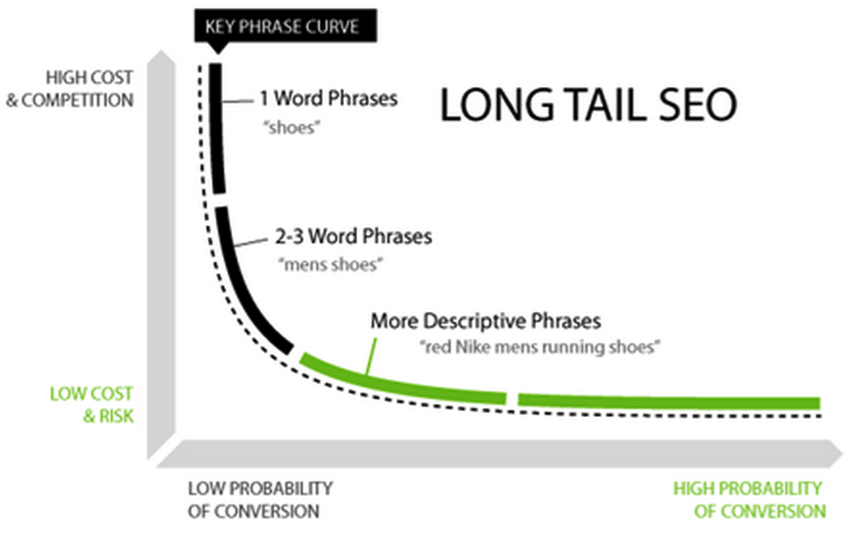
- Short tail Keywords: short keywords with high search volume and lots of competition.
- Long tail Keywords: long keywords with lower search volume and much less competition.
3. Prioritize the keywords
Once you have identified which keywords are all relevant to you, you can start prioritizing them based on different evaluation criteria, such as:
- Volume
- Intention
- Competition
You need this prioritization to focus on keywords where you can make the biggest (financial) impact in the shortest amount of time:
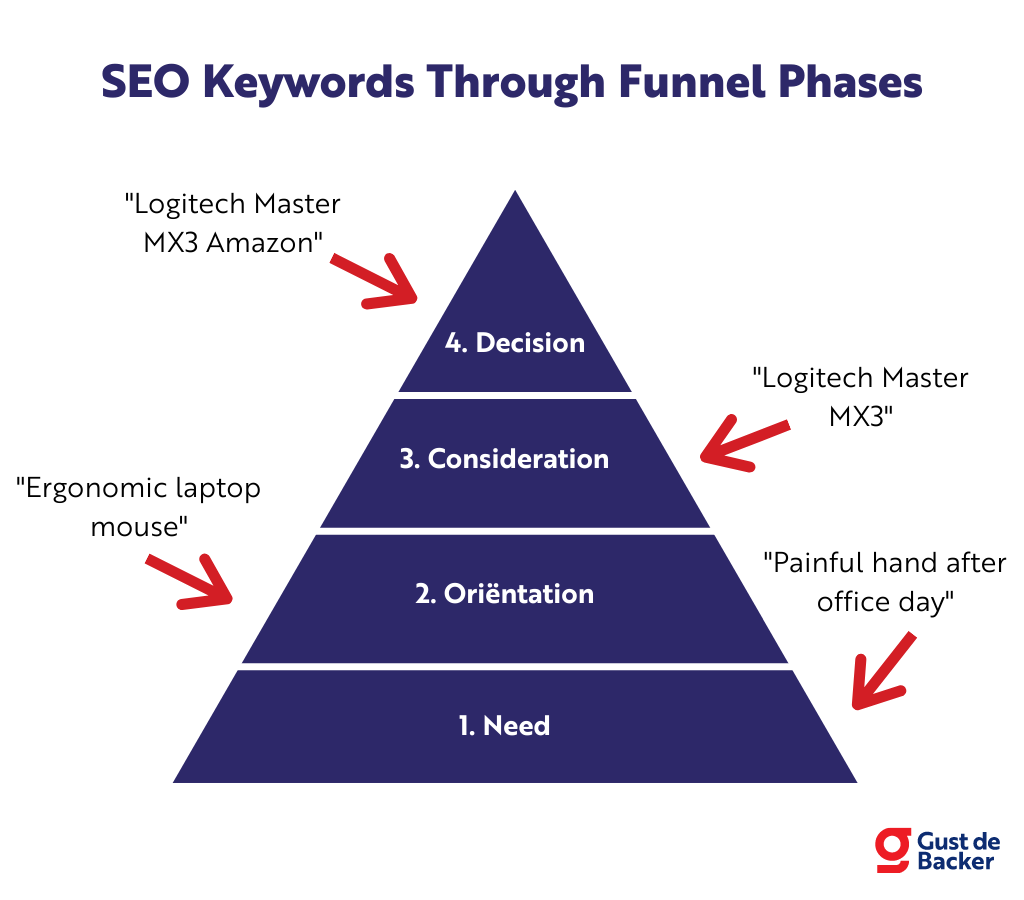
4. Determine follow-up actions
On the basis of your keyword research, determine follow-up actions.
Suppose you have a lamp store and see that on Google 2,400 people monthly search for ‘Light shop [location]’ then you will have to take action to actually score on that keyword.
In that case, you can start looking at the top search results. There you will see that local search results appear at the top of Google. The action you can take in that case could be to optimize your Google My Business listing.
5. Check the SEO Technique
You can have quality content, but if the technique of your website is not good then Google is not going to be able to see how good your content is.
Make sure you periodically check the technique of your website, especially after periods when a lot of changes are made.
There are numerous tools in which you can do a simple SEO check, such as Ubersuggest, SEMrush or SEObility.
6. Create a content calendar
Using a content calendar, you can structurally build on sustainable SEO growth.
The content calendar can be the result of the action list that comes from your keyword research. In it, you want to know what content you are going to post on which channel and when.
This avoids being reactive and ensures that there is always an underlying strategy in place.
There are plenty of examples of a content calendar on the Internet.
7. Create, distribute and evaluate the content
Once the strategy and calendar are ready, you can start implementing the content calendar by starting to create, distribute and ultimately evaluate the content.
For enthusiasts, complete the PDCA circle again 😉
In this, try to include proven tactics such as best times to post, amount of links, length, type of content, etc.
In addition, it is important to determine follow-up actions again based on your insights.
Important KPIs to keep an eye on are:
- Traffic from Google / organic.
- Sales or leads from Google / organic.
- Number of impressions in Google Search Console.
- Number of clicks in Google Search Console.
- Positions on certain keywords.
8. Build a strong link profile
The final stage is actually promotion of your organic content.
If you have quality content you will automatically start gaining backlinks, but you can also encourage this by actively engaging in link building.
In addition, you can also choose to cash in on your organic efforts using ads. You could choose to run Google Ads or perhaps boost organic social media content with paid outreach.
6 SEO Trends 2023
There are 6 SEO trends to consider in 2023:
- Non-Google Search Engines: Google is the largest search engine, but other platforms are starting to gain market share. Examples include Amazon, Booking.com, Ebay, Marketplace, Bol.com, etc.
- Shortform Video: the type of content you see coming by mainly on TikTok, YouTube Shorts, Snapchat and Instagram Reels is here to stay. In certain searches, you can see that TikTok already has a dominant position in the Google search results:
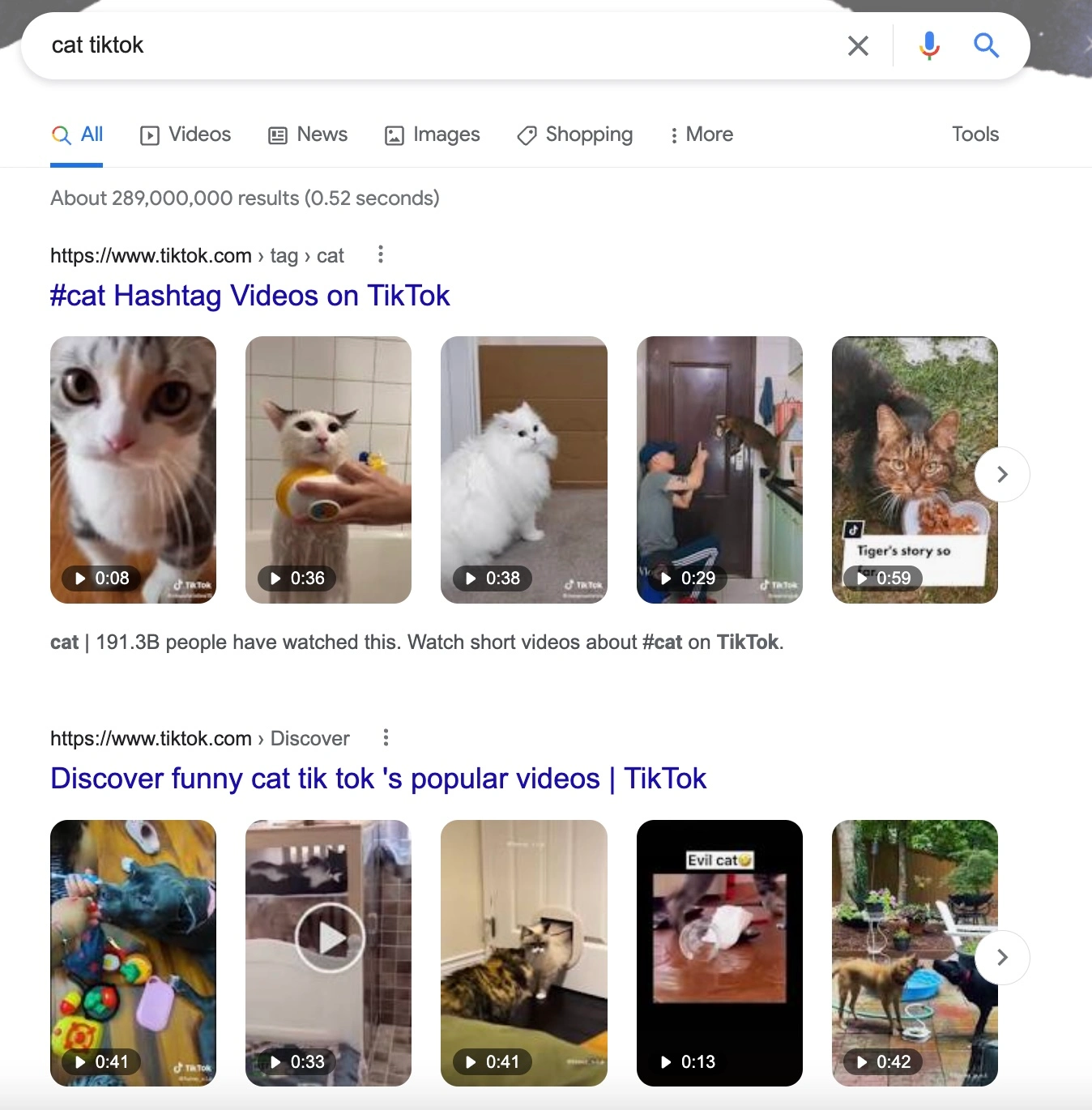
- AI Copywriting: quality is becoming more important than ever, as it is possible with the help of AI to create gigantic amounts of content in no time, look for example at Jasper.ai or Copy.ai.
- User Intent: Google is getting better at recognizing the intent behind a search query, so it is also important to respond to the right intent with your search result:
- Informational: the searcher is looking for information. For example, “How hot is the sun?”.
- Navigational: the searcher is looking for a specific place within a website. For example, “Apple customer service.”
- Transactional: the searcher is looking to make a purchase. For example, “buying Iphone 14 Pro.”
- Commercial: the searcher is in the market for a product or service, but is still in the orientation phase. For example: “Gift for her.”
- Voice Search: abroad, voice search is already widely used; in the Netherlands, its share is not yet as high. A speech-driven device only returns one result, so it pays to capitalize on long-tail keywords:
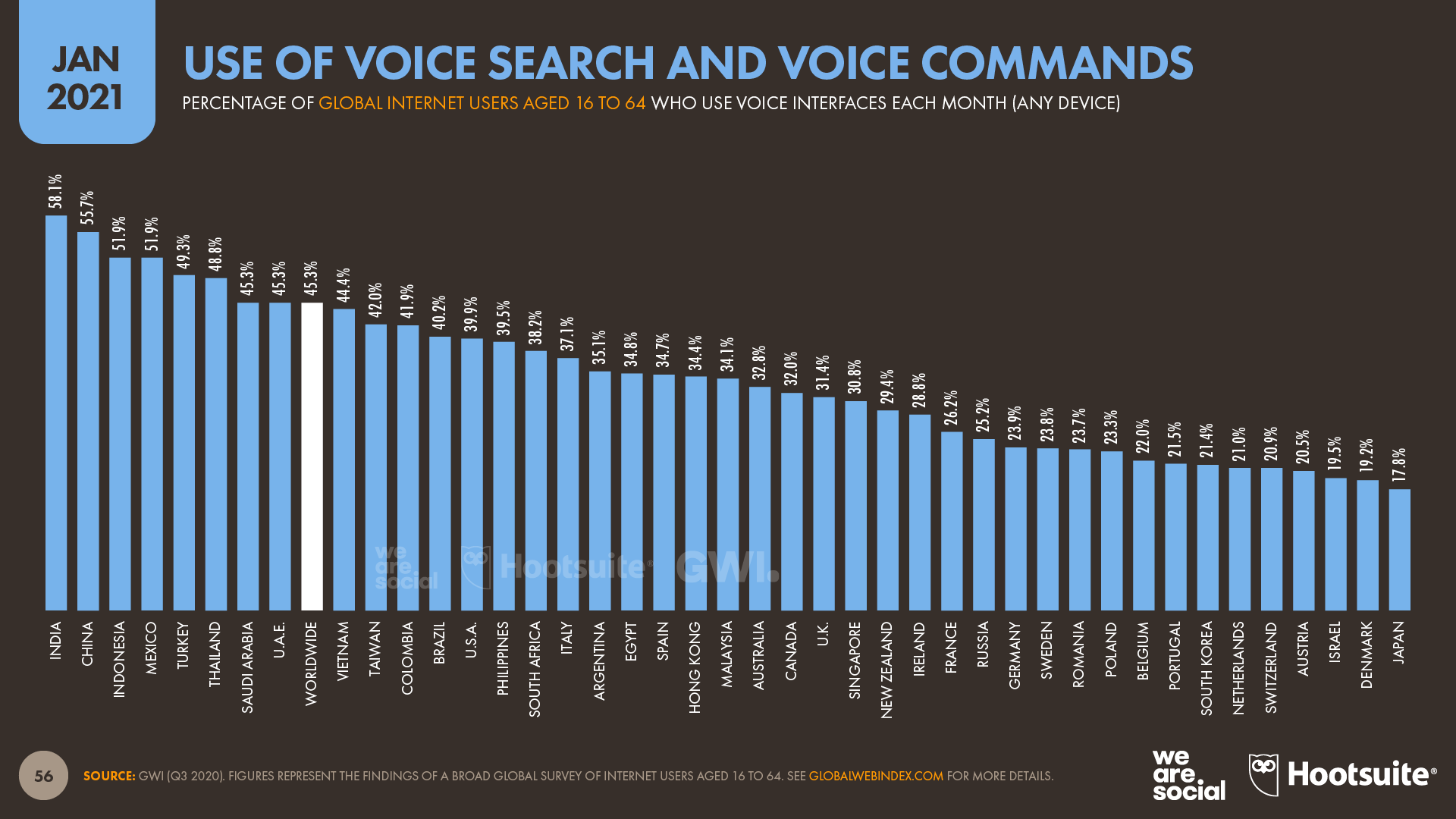
- Brand: with the more important EAT and Expertise, Authoritativeness & Trustworthiness signals, your brand and therefore your authority is still of undeniable value.
SEO Tools
There is an enormous amount of tooling around SEO, which can be divided into several categories:
- All-in-one: SEMrush, Moz, Ahrefs, SERanking, Übersuggest
- Keywords: Google Trends
- Analytics: Google Analytics, Google Search Console, Google Campaign URL Builder, Bing Webmaster Tools, Google My Business, Google Merchant Center, Google Data Studio
- Content: Google Trends, Answer the Public
- Engineering: ScreamingFrog, Structured Data Tester, Pingdom, Google Pagespeed, Google Mobile Friendly Test, GTMetrix
- Link Building: Google Alerts, Mozbar
SEO Outsourcing
There are 3 options when it comes to SEO:
- Doing it yourself
- Hire or hire an SEO specialist
- Hiring an outside SEO agency
All 3 have advantages and disadvantages:
| Doing it yourself | SEO Specialist | SEO Agency | |
| Price | ++ | + | – |
| Speed | + | ++ | – |
| Result | — | + | ++ |
Of course, it varies by company, SEO specialist and agency, but in general, you can see that doing SEO yourself is fairly inexpensive and yields few results.
Hiring an SEO specialist is a step in the right direction where you can get SEO results relatively quickly.
SEO should always be the means and not the end, there should be an objective to which SEO contributes. An agency that does not specialize only in SEO can be a good choice in the long run, because an agency thinks across channels in what the right direction for your business could be.
In addition, an agency also often benefits from a more diverse range of knowledge.
Now it’s your turn…
Now you’re armed with enough knowledge to get started with SEO.
I’m curious, what is going to be the most important SEO development for your industry?
Let me know in a comment.
P.S. if you would like additional help you can send me an email at [email protected]
Frequently Asked Questions
SEO (Search Engine Optimization) is improving a website’s ranking in search engines. The higher the ranking, the more likely people are to find the site. SEO can involve optimizing the content, structure and coding of the Web site and creating backlinks to the site from other Web sites.
You can do SEO yourself, but to do it really well and get the best results, it is almost necessary to hire an SEO expert or work with an agency.
It’s all about understanding how search engines work and what people are looking for. There are many good resources to help you learn, and it is something you will only see results from in the long run.
SEO positions you’ve worked for years for can be undone with a few small mistakes, or in other words, a bad migration costs a huge amount of organic/free search traffic.
There is a whole range of points to consider with a website migration.
There are a few ways to find out how competitors are doing online. You can use online tools such as Alexa or Compete, or look at search engine results pages (SERP) to see what positions they are in. It is also possible to look at their website traffic and social media statistics to get an idea of their success.
SEO is a long-term journey in which it depends heavily on the company how much SEO will actually pay off. If competitors have a strong presence and claim important positions in the search engine, you are going to spend extra on Google Ads to still rank well there. Then good SEO will give you everything you would otherwise have spent on Google Ads and perhaps even more.
When looking for an SEO specialist, it is important to keep in mind that not all SEO services are created equal. Some companies offer turnkey solutions that may be effective for some businesses, but may not be the best option for your business. It is important to find an SEO specialist who will take the time to understand your business and goals before developing a plan of action. In addition, it is a good idea to check whether potential SEO specialists have experience and with which clients they have gained that experience.
There are many factors to consider when choosing an SEO agency. You can evaluate the experience of the agency, their approach to SEO, and the results they have been able to achieve for their other clients. You also want them to be up to date on the latest search engine algorithms and trends.

![Business-Driven Marketing (BDM): 8 Steps to Drive Business Impact [+14 Templates]](https://gustdebacker.com/wp-content/uploads/2024/07/Business-Driven-Marketing-BDM.png)
![Automate ~30% of Repetitive Marketing Tasks with AI: 5 Easy Steps [+ 7 Expert Prompts]](https://gustdebacker.com/wp-content/uploads/2024/07/AI-in-Marketing.png)
![Customer Journey Map (2025): How-to & Examples [+ Template]](https://gustdebacker.com/wp-content/uploads/2023/11/Customer-Journey-Map.png)
Can you be more specific about the content of your article? After reading it, I still have some doubts. Hope you can help me.